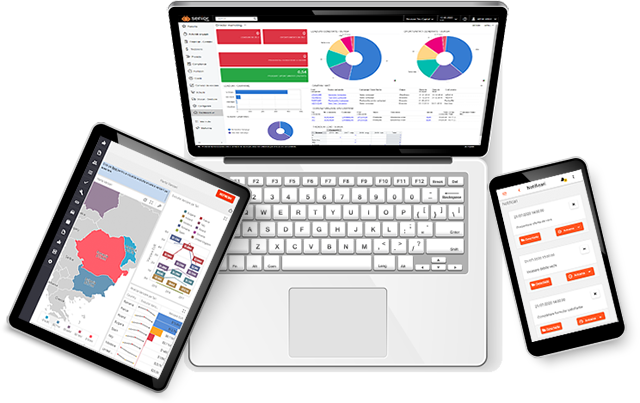- What does ERP mean?
- What is the history of ERP?
- What is an ERP system?
- The functionalities of an ERP software
- What are the benefits of an ERP system for businesses?
- ERP systems fit for any type of business
- Differences between an ERP system and an accounting software
- ERP vs CRM
- Examples of ERP systems from Romania
What is ERP? Advantages, benefits and functionalities of an ERP software
Enterprise resource planning (ERP) refers to a software that companies use to optimally manage their entire business. An ERP system can be used in industries such as distribution, manufacturing, services, retail, service, construction, e-commerce and automates accounting, procurement, logistics, sales, HR, etc. What it is, what such a system entails, how it works and what benefits it brings are issues addressed by this article. The explanations and definitions of ERP systems are complemented with examples and successful implementations, criteria for selecting ERP software and case studies.
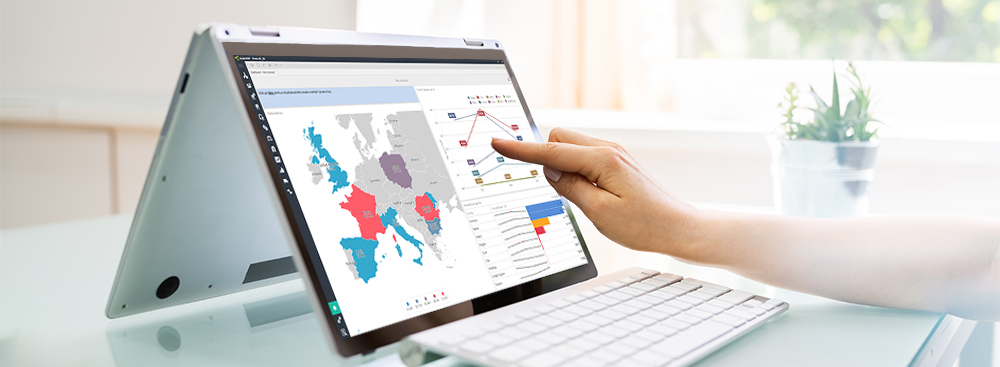
What does ERP (Enterprise Resource Planning) mean?
ERP definition
ERP is an acronym for the English term “Enterprise Resource Planning” which. In the Romanian business environment, the term is usually used in expressions such as “ERP program”, “ERP application”, “ERP system”, “ERP software” or “ERP solution”. An ERP system is used by companies to manage resources. The software facilitates the integrated management of processes and operations in different business areas: purchasing, sales, accounting, manufacturing, customer relationship management, project management and other activities concerning logistics.
What is the history of ERP?
The beginnings of ERP systems
The name was given in 1990 by technology analysts to the software system that handles business management, ERP – Enterprise Resource Planning. But the history dates back to 1913, when Ford engineer Whitman Harris developed the EOQ – Economic Order Quantity – model. For about 50 years, this paper-based manufacturing system has been the standard for production planning.
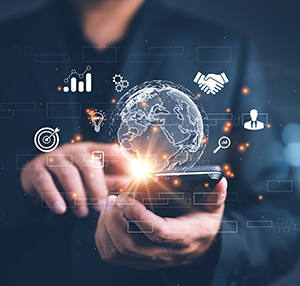
The evolution of ERP softawre
The evolution of technology since then has led to the emergence of similar systems covering other business activities (customer relationship management, human resource information management, financial integration), leading to a new type of business management software: the ERP system. Thus, the marketing and sales, inventorying, manufacturing, finances and accounting and human resources departments could be integrated into the system through interdependent modules.
Modern management softawre system
In order to efficiently give answer to economic developments and based on technological innovations, applications are becoming more complex, with intuitive web interfaces, which enable more efficient and comprehensive business management.
Thus, ERP systems have come to encompass different industries and types of activities, making it possible to easily integrate departments, regardless of the areas they cover. The global ERP systems market reached a valuation of $39.65 billion in 2019 and is expected to reach $65.2 billion by 2025.
What is an ERP system?
In order to find out what an ERP system is, we first have to think about the fact that in an organization, information is often dispersed. Thus, an ERP is the tool that supports the translation of all information into a single, integrated software. It is based on a single IT platform where the management, automation, monitoring and control of these processes and activities take place. Implementing Enterprise Resource Planning solutions is possible in any company. These software systems can be deployed for different types of activities: manufacturing, distribution, services, construction, retail or e-commerce.
What does an ERP software do?
The software deals with the management of business processes and activities, it provides centralized access to company data and establishes a tight link between key information, users, departments and other software systems. The software enables the automation of a wide range of operations, which results in streamlined workflows.
When we talk about such a software system, data is the main unit of measurement and the database is the central repository in which it is stored and organized. The link between the database and all functionalities that the system performs is made through the application. It is responsible for collecting, validating, processing, transferring or exporting data, which it performs through the interface.
How does data reach the application?
The ERP application can collect data using various methods:
- Operator input: from the keyboard or directly – by scanning barcodes, for example.
- Import from other databases or systems
- Transfer using EDI (Electronic Data Interchange) technology
The functionalities of an ERP software
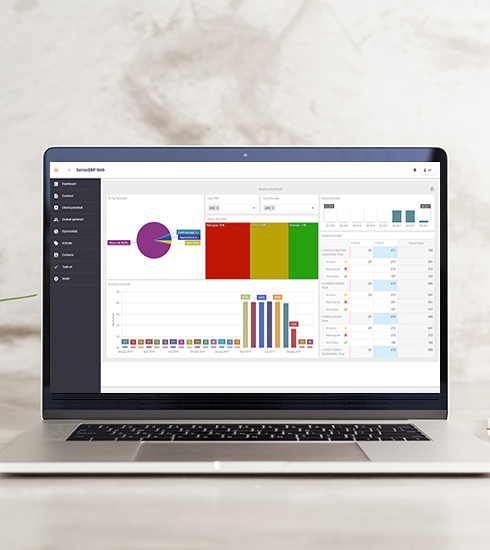
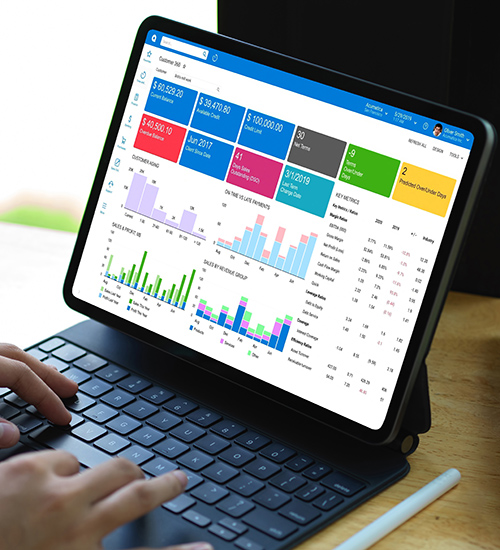
Find out more about the ERP systems
Senior Software’s ERP solutions, with over 500 successful implementations, have a wide range of integrated functionalities that successfully cover all business components, regardless of the company’s field of activity.
What are the benefits of an ERP system for businesses?
ERP systems fit for any type of business
Enterprise resource planning systems have become indispensable for optimizing operations and making strategic decisions in various industries. By choosing an ERP system tailored to their industry and business specifics, companies can benefit from specific functionalities that will help them streamline business processes and increase productivity.
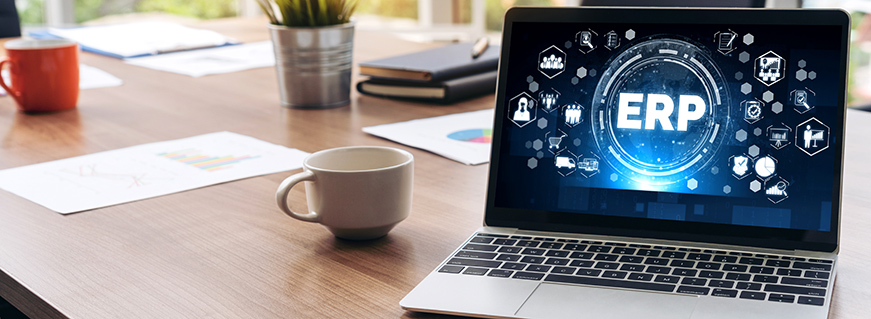
Differences between an ERP system and an accounting software
ERP software systems are often confused with accounting programs, with many considering them one and the same. However, even though they have similar functionalities in some areas, the differences are major. Thus, while an accounting program is limited to the financial-accounting area of the business, an ERP software covers all components of the business, offering specific benefits to each department.
An accounting program manages receivables, payables, inventory value of fixed assets, as well as the financial-accounting reporting area. In addition to the above, an ERP system includes functionalities related to inventory management, supply chain management, sales through various channels, customer relationship management, project management, production management and more. In this way, the application covers not just one business function, but all of them, bringing them together in a single system to provide visibility and control over the entire business.
ERP vs CRM
The difference between the ERP and CRM solutions
CRM is the acronym for Customer Relationship Management. A CRM software system manages all the ways in which customers interact with a business. CRM functionalities were initially focused on sales departments, but as they were developed, such solutions became capable of managing other components of a business (customer relations, marketing, service, etc.).
The fundamental difference is that the ERP system is generally aimed at managing financial data and financial-accounting departments, while CRM is aimed at customer data used by sales and customer service departments. CRM solutions generally aim to increase profits by increasing sales, and they centralise data from the following areas: marketing, sales, contact management and customer support.
An ERP software solution, on the other hand, aims to plan and manage resources as efficiently as possible in order to achieve lower expenses and provide greater control over costs and business processes. When we talk about ERP systems or solutions, they are mainly used by human resources, finance & accounting, production, purchasing, delivery departments.
Examples of ERP systems from Romania
In the Romanian ERP software solutions market there is a wide variety of systems, local and foreign, based on different technologies and covering more or less complex business flows. Thus, whether you choose a Romanian ERP or a foreign software, the selection of such a system takes into account, among other things, the degree of complexity of the company’s activities.
Types of ERP software in Romania
Take for example SeniorERP and SeniorXRP – two ERP systems offered by Senior Software. Both solutions offer specific ERP system functionalities that are indispensable for the types of companies they are addressed to. These two examples of systems – SeniorERP and SeniorXRP – although they have a wide range of similarities, have capabilities that differentiate them precisely in order to respond efficiently and accurately to the type of business they address. These are essential because companies, in turn, differ according to size, industry, length of workflows etc.
